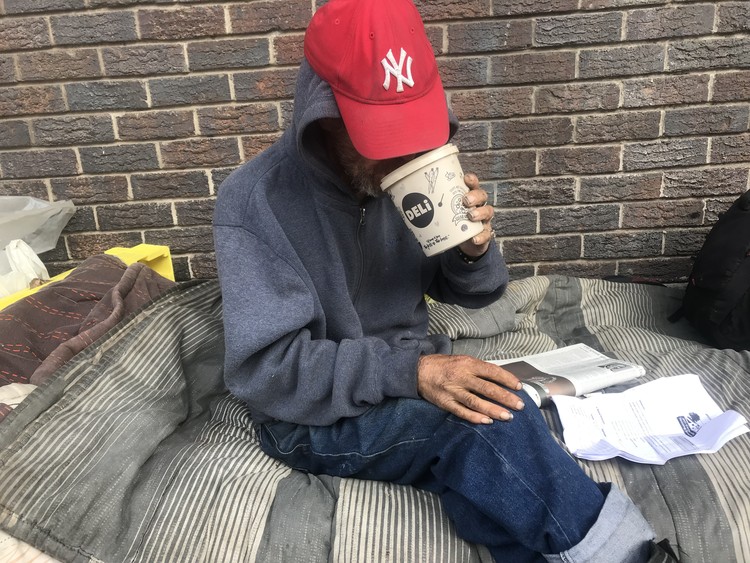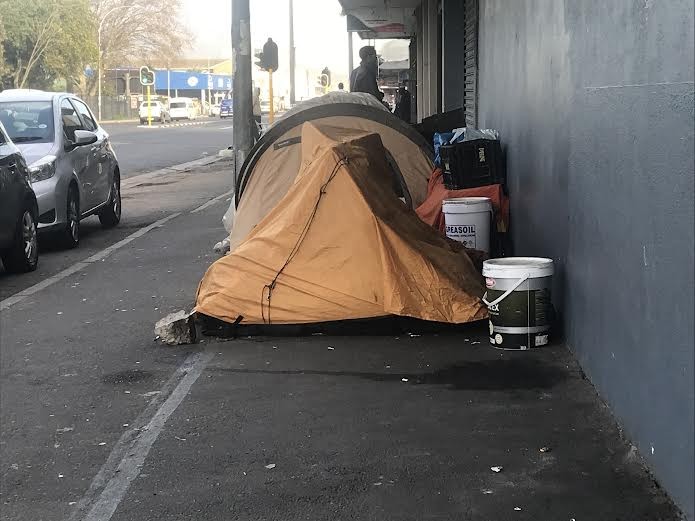Living on the streets of Vasco: “Law enforcement keeps coming but I still return”
Stephanus Nel is one of an increasing number of people living on the streets in the Cape Town suburb
Stephanus Nel has been living on the streets of Vasco for years. He says residents of the nearby flats often bring him food and hot water for coffee. Photos: Tariro Washinyira
- An increasing number of people are living on the streets in Vasco, Cape Town.
- Other residents of the area want the City of Cape Town to move them into accommodation.
- The City says it is doing a survey of homeless people and intends to increase the number of Safe Spaces.
Law enforcement officers keep moving him away, but he keeps coming back, says Stephanus Nel, who lives on the street in Vasco.
Nel, 56, is one of an increasing number of people living on the streets in the Cape Town suburb. The rise in the number of homeless people on the streets of Vasco has prompted concerns from people living in houses, who want the City of Cape Town to find accommodation for homeless people.
Photos taken by residents a year ago and by GroundUp on 14 July this year show far more people are now living in tents, cardboard and plastic shelters along Riebeek Street. Other people have moved onto the street next to Vasco train station.
Nel showed GroundUp an application he had made to rent one of the new flats under construction at Goodwood station. “I’ve applied for a single room for R900,” he said.
Nel said he is attached to the area because he was born nearby, in Goodwood. He and his sister inherited their parent’s house but fell behind with their rates and water payments. They owed the City more than R500,000. “The council was going to sell the house to get back their money. So we sold the house and split the money between me, and my sister and paid the council. I could have bought a smaller house, but I abused the money and lived recklessly.”
“I know a lot of people in this area. People in the complex are like my friends, they bring warm food and hot water in the morning to make coffee.”
“Law enforcement comes all the time, but I still return,” said Nel.
But some residents of houses are concerned about the increasing number of people on the streets.
Salon owner Miriam Jola, who has been in the area since 2008, said: “Residents around here complain that these people need to be removed and not sleep on their pavements.”
When GroundUp visited the area, many of the homeless people said they had been living there for more than two years. Some said the nearest shelter, the Elim shelter in Elsies River, is always full; others said they preferred to live on the streets.
Irene Jacobs, 60, lives in a tent on Voortrekker Road with her 19-year-old son who has a lung problem. Her 21-year-old daughter lives in the tent next to hers. Jacobs has no ID, she said.
She has been staying on the streets for 13 years. “My mother died and my stepfather’s children threw me out of the house with my children. At that time, I was working at a school in Atlantis as an assistant teacher. I lost my home and income at the same time. From Atlantis I stayed on the streets of Elsies River and at the Elim shelter, then I moved here.
“In Vasco I’ve spent four years on the streets.”
Irene Jacobs and her 19-year-old son live in a tent next to her daughter’s tent. She has lived on the streets for 13 years.
Jacobs said she hasn’t been getting a social grant since January because her ID was stolen from her backpack, with her medication. She has asthma and a hip problem. She had an operation after she was hit by a bicycle.
She said she’d have liked to stay on at the shelter, where she paid R1,000 a month, but she had problems with other residents who stole her belongings and “always wanted to fight”.
But Shafeek Ortell, manager at Elim Night Shelter, said in his ten years of service there he had only ever seen one fight.
“I can almost guarantee our clients’ safety. The main reason for the non-violent atmosphere is because we ask our clients to refrain from using foul language. And to respect each other. On the initial intake of any client, our rules and regulations are read to them.”
Ortell said Elim Night Shelter had 70 beds, 19 for women and 51 for men, and Elim House had 14 private bedrooms which can accommodate 18 people, including four couples.
The shelter offered rehabilitation and entrepreneurship courses, and the only requirement for entry was an ID, passport or refugee papers. “If these are lost or stolen, an affidavit reporting the loss/theft is accepted.”
“Unemployed clients pay R20 per day or R600 per month, employed clients pay R40 per day or R1,200 per month and SASSA grantees pay R1,100 per month. The service fees include a bed, hot shower, locker, three nutritional meals daily and access to social services.”
Ortell said people were expected to leave the shelter during the day and were encouraged to look for work. Those in the area could come back for lunch. “Only pensioners and clients on rehabilitation programmes are allowed on the property during the day. All clients can stay in on weekends.”
“Our clients can stay for six months and will receive extensions if they show progress in personal development. They can then apply for accommodation at our second phase facility where they can live independently, whilst being taught the necessary life skills to assist them to become proud members of society.”
Increasing numbers of people are living on the streets in Vasco.
Mayoral Committee Member for Community Services and Health Patricia Van der Ross said the City funded and worked with NGOs working with homeless people.
“The City’s Social Development officials are busy with a metro-wide survey of the social circumstances of those on the streets. We are offering social assistance to leave the streets for good, including space at NGO-run shelters and City Safe Spaces, which offer dignified transitional shelter coupled with social programmes to reintegrate people into society.”
Asked about numbers of people on the streets in Vasco, she said, the City is awaiting an enumeration from the latest census, due this year. “With the City’s last enumeration in 2018-19, there were 4,000 people living on the street and 2,000 in shelters. This number has grown given the pandemic and related impact.”
The City would spend R230-million over three years to expand Safe Space facilities beyond the city centre and Bellville, she said. “We want to see our city becoming an even better place to live in over time, with reliable municipal services, public facilities we can take pride in, and support for the most vulnerable, including help for the homeless to get off the streets.”
“Where offers of social support and shelter are refused, the City has no option but to approach the courts for an eviction order,” said Van der Ross. “No person has the right to reserve a public space as exclusively theirs, while indefinitely refusing all offers of shelter and social assistance.”
A spokesperson for the City said law enforcement officers conducted two weekly “clean-up and by-law enforcement operations at sites of unlawful occupation of public spaces” in the Goodwood-Vasco area.
“The City is also preparing to approach the courts for eviction orders where our offers of social support are being persistently refused.”
Support independent journalism
Donate using Payfast

Don't miss out on the latest news
We respect your privacy, and promise we won't spam you.
Next: Government departments owe millions to Matatiele Local Municipality
Previous: Inside a Cape Flats minstrel band
© 2023 GroundUp. This article is licensed under a Creative Commons Attribution-NoDerivatives 4.0 International License.
You may republish this article, so long as you credit the authors and GroundUp, and do not change the text. Please include a link back to the original article.
We put an invisible pixel in the article so that we can count traffic to republishers. All analytics tools are solely on our servers. We do not give our logs to any third party. Logs are deleted after two weeks. We do not use any IP address identifying information except to count regional traffic. We are solely interested in counting hits, not tracking users. If you republish, please do not delete the invisible pixel.



